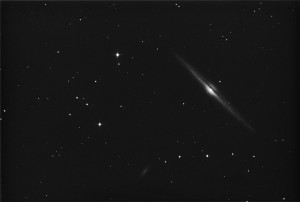As you might have heard, an asteroid (2011 MD) buzzed us this afternoon. The asteroid was discovered on the 22nd by the Lincoln Near Earth Asteroid Research program (LINEAR). By the 23rd a call went out for astrometric observations to further refine the orbit of the asteroid. Time was being requested at the Goldstone Radio Observatory in order to ‘image’ the interloper as it passed and precise positioning would be required.
I started observations Friday night (24th). Since the asteroid was comparatively very close, its orbit was being significantly changed by the earths gravitational field. Normally, the numbers that define an orbit (orbital elements) change very little, absent any external interference. But, the closeness and speed of 2011 MD meant that the numbers were changing very rapidly. My planetarium software can directly download the latest elements from the Minor Planet Center and I did so just before my time on the scope Friday night. The software then takes the numbers and calculates the apparent position of the object as viewed from here. After numerous exposures I saw nothing. It was easy to verify that I was looking where the asteroid was supposed to be, and I was spot on. The problem could have been two things: the position was bad or the asteroid was too dim.
Strike one.
Saturday night was the astronomy club meeting, but right after I got home, back out to the observatory. I once again downloaded the latest orbital elements. The position had moved (as expected) and was reasonable for a days worth of motion. Since the rock was coming directly towards us, most of the motion was radial to us with not a whole lot of movement across the sky. At least not yet. I took exposures until 0200 local. Still nothing. Again the exposures were right where the asteroid was supposed to be. However, by now there were plenty of exposures taken by other observers and they showed the object to be bright enough that I should have been able to see it.
Strike two.
Chatter on the discussion boards I frequent indicated that others were also having problems with the asteroid’s position; at least I wasn’t the only one. By now it was Sunday afternoon and it was then I remembered I had problems finding a close pass last year. Ultimately, I had to ‘manually’ find the position and point the scope. Just like the last two nights, I downloaded fresh orbital elements and let the software calculate the position. I also had the Minor Planet Center calculate the position using its own elements. I downloaded a tabular listing of those positions versus time. I then rolled the time forward on the software to that evening and checked the position of the asteroid against the listing that the MPC calculated. They weren’t even close. Although the software I use is normally right on, it looks as if the calculated positions are in error if the object is close and fast. So I highlighted my position listings and waited for it to get dark and for the clouds to clear.
Strike three.
Hopefully, I’ll remember this lesson and not have to learn it a third time for the next close pass.
Although most of the news coverage implied that the asteroid passed us, in reality it was ahead of the earth and the earth overtook it. It was close enough to pass between the earth and our GPS satellites. The task now is to get observations of 2011 MD as it departs to measure the changes in its orbit caused by the close pass to the Earth.
